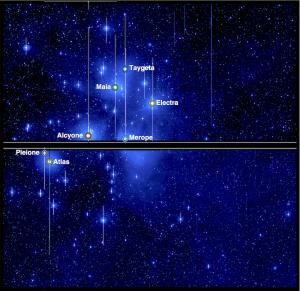Astronomers discover variability in the Seven Sisters of the Pleiades cluster
University of Hawaiʻi at MānoaAssistant Astronomer, Institute for Astronomy
Roy Gal, (301) 728-8637
Associate Specialist, Institute for Astronomy

The Pleiades star cluster, as seen by the Kepler Space Telescope. Image credit: NASA/ Aarhus University / T. White
The brightest members of the Pleiades cluster form a spectacular group of naked-eye stars that have played a central role in cultures around the world for millennia. Native Hawaiians used the rise of the Makaliʻi to navigate the seas and mark the beginning of the "tax-collecting" season, while the "Seven Sisters" feature prominently in ancient Greek mythology. But not everything is known about these famous stars.
Now, an international team of astronomers, including Daniel Huber from the University of Hawaiʻi Institute for Astronomy, used the Kepler Space Telescope to perform the most detailed study to date of their variability -- with some interesting new discoveries.
The study revealed that six of the seven stars are slowly-pulsating "B" stars, a class of variable star in which the star's brightness changes with day-long periods. The seventh star, Maia, is different: It varies with a regular period of 10 days. Follow-up observations using ground-based telescopes demonstrated that the variability is due to large chemical spot on the surface of the star, which comes in and out of view as the star rotates with a ten day period.
"Sixty years ago, astronomers had thought they could see variability in Maia with periods of a few hours and suggested this was the first of a whole new class of variable stars they called 'Maia Variables,'" says lead author Dr. Tim White from Aarhus University in Denmark, "but our new observations show that Maia is not itself a Maia Variable!"
The study was made possible through a new algorithm to enhance observations from the Kepler Space Telescope, now in its extended K2 Mission. Because Kepler was designed to look at thousands of faint stars at a time, stars like those in the Pleiades are too bright to observe with conventional methods. Aiming a beam of light from a bright star at a point on a camera detector will cause the central pixels of the star's image to be saturated, which makes it impossible to accurately measure the total brightness of the star. This is the same issue that makes everyday digital cameras unable to capture both faint and bright objects in the same exposure.
"The solution to observing bright stars with Kepler/K2 turned out to be rather simple. We're chiefly concerned about relative, rather than absolute, changes in brightness. We can just measure these changes from nearby unsaturated pixels, and ignore the saturated areas altogether," White explains.
But changes in the satellite's motion and slight imperfections in the detector can still hide the signal of stellar variability. To overcome this, the authors developed a new technique to weight the contribution of each pixel to find the right balance where instrumental effects are cancelled out, revealing the true stellar variability.
The Pleiades study marks only the beginning of investigating bright stars with Kepler/K2. "Naked-eye stars are benchmarks for solving many key problems in modern astrophysics," says Huber, co-author and Principal Investigator of a NASA-funded program to study bright stars with Kepler/K2. "By combining the pulsation frequencies detected by Kepler with complementary observations from the ground, for example using telescopes here on Maunakea, we will be able to study the structure and evolution of Pleiades members and other bright stars in unprecedented detail".
No signs of exoplanet transits were detected in this study, but the authors show that their new algorithm can attain the precision that will be needed for Kepler and future space telescopes such as the Transiting Exoplanet Survey Satellite (TESS) to detect planets transiting stars as bright as our neighboring star Alpha Centauri.
The results are published in the August 11th issue of the Monthly Notices of the Royal Astronomical Society, and can be found online at https://arxiv.org/abs/1708.07462.
For more information, visit: http://www.ifa.hawaii.edu/info/press-releases/k2_pleiades/
